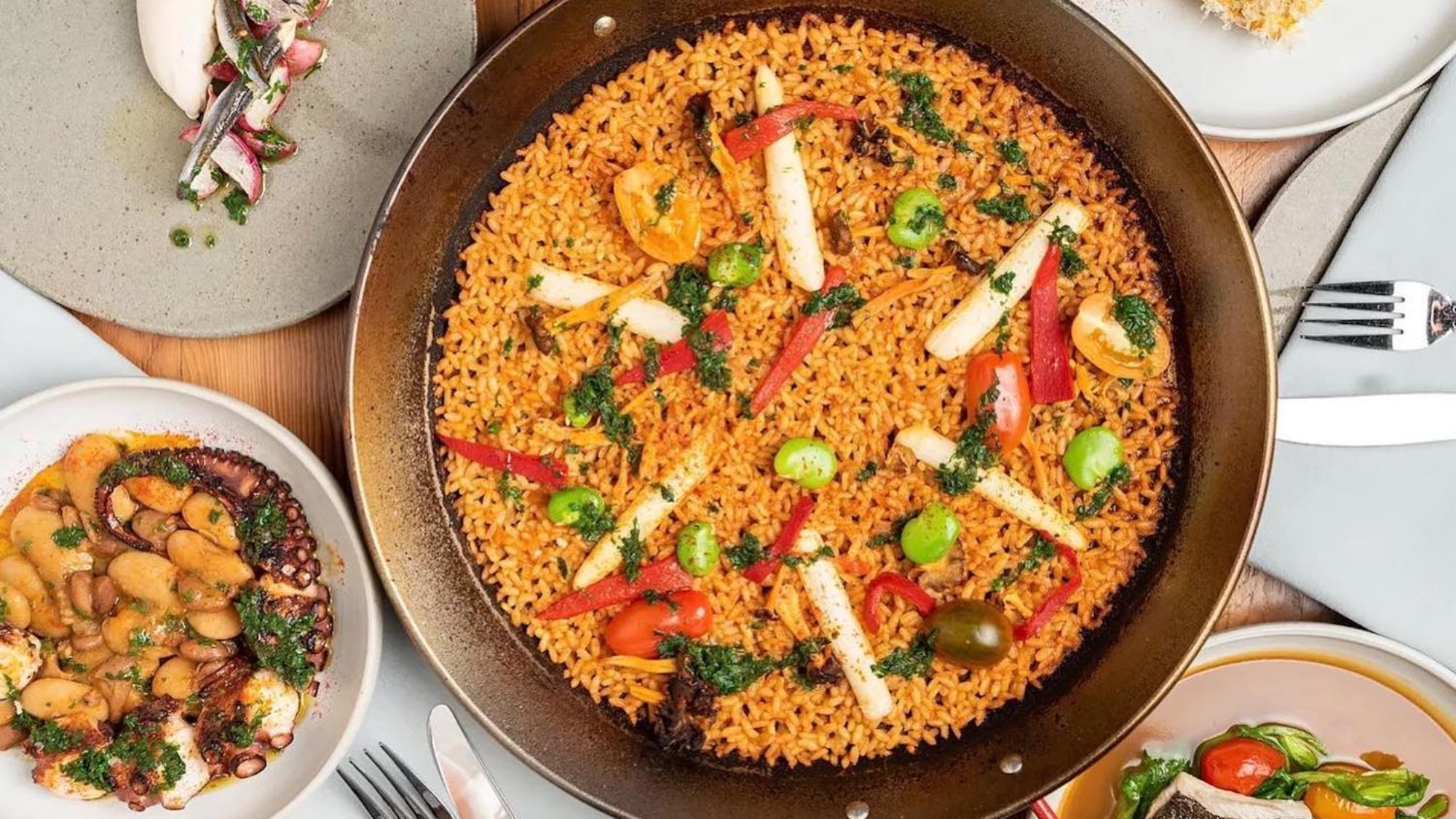
How Teresa Montaño Riffs on Spain at Otoño, As Seen Through Five Dishes
For Teresa Montaño, the Los Angeles chef who opened progessive Spanish-inspired restaurant Otoño in 2018, it’s not just a multivalent love of cuisines that drives her career. It’s also her competitive nature, which could only have come from playing soccer since she was 4.
So, yes, she grew up in a large Hispanic family in Albuquerque, N.M., and Montaño credits her mother and grandmother for inspiring her to cook soulfully. But her creative ambitions? That you can track to her time at Pepperdine University, where she played Division 1 soccer as goalkeeper.
Perhaps not entirely pleased with the food at Pepperdine, she found herself experimenting with an ever broader range of flavors and fresh ingredients from wherever she could find them — even the cafeteria salad bar — perfecting a repertoire of dishes that would make any college student filled with envy. Think pasta with cherry tomatoes; fried rice; even chicken Parm. And so, the parallel between soccer and cooking became evident.
“I love the team atmosphere,” she says. “And being a goalkeeper is very similar to being a chef. You’re able to see the whole field. You’ll have a couple minutes of fame. But when you do, you better perform. So you have to be super dialed in to whatever’s happening.”
The link between Albuquerque, Malibu, and Spanish cuisine came while Montaño worked with Susan Feniger and Mary Sue Milliken at their downtown pan-Latin concept Ciudad (now Border Grill). There, the menu leaned more toward Spain, with paella cooked outside on the patio, and killer sangria. The experience propelled Montaño to open Pasadena’s beloved Ración and then Highland Park’s Otoño, where she was determined to both harness a Spanish repertoire and break it from its typical mold.
Montaño honors Spanish flavors and traditions at Otoño, but she also cooks with a free spirit. That might translate to, say, paella and tapas made with Asian-originating ingredients, or playfully twisting patatas bravas into something resembling a savory churro. The result are dishes that feel utterly Angeleno.
Here, Montaño lays out the details of her restaurant, as seen through five standout dishes.
- David Kuo Brought the Westside the Taiwanese Soul Food It Needed
- Ten Essential Restaurants Across America, Fall 2021 Edition
- At Bake n Broil, Nothing Is More Precious Than The Last Chicken Pot Pie
- The Resy Guide to 2021 Michelin Winners in California
- Everything You Need to Know About Greekman’s, Silver Lake’s Key Pop-Up

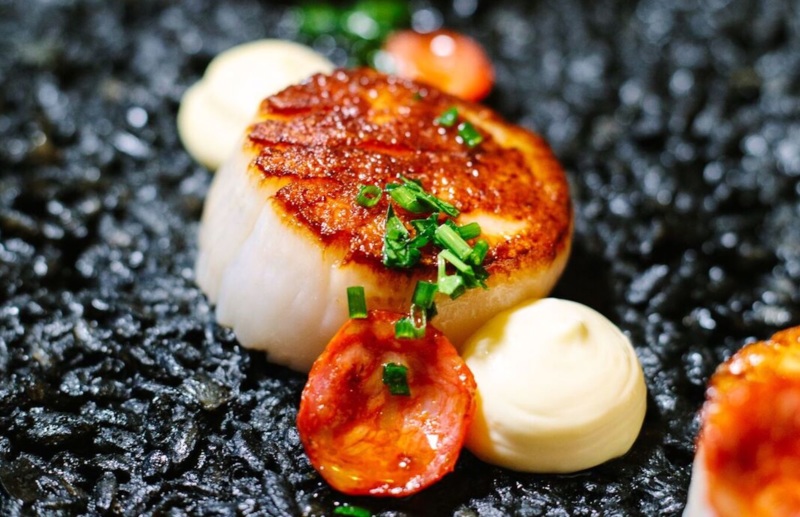
1. Paella Negra
“This is our squid ink paella. I’ve had it a few times in Spain, and it’s always delicious. It’s stunning on the plate. I like the mystery and awe of it. Like, what am I getting myself into? It looks so intimidating. It looks really rich because it’s black and gooey. So what I wanted to do was make it really gentle on the palate and elegant but also still embrace the Spanish flavor of it.
I used to do a version of fideuá negra at my first restaurant, Ración, and I was a little more classic then in terms of the flavor profile. It has more rich seafood broth. At Otoño, I wanted a little more nuance. I thought dashi was the best way to go about it.
And then zooming out from that a little bit, I was thinking about all the elements of what makes a great paella. I thought about the type of rice, the amount of rice, the rice-to-pan ratio, how it’s built, and layering the flavors. And it was really important for me to be able to make a paella in under 20 minutes. So I had to study the paella, and how to cut out time and get as much flavor as possible concentrated to make it feel like it’s been cooking for almost an hour.
In thinking about all of the things that impact the flavor, the broth was a big thing for me. I thought about all of these amazing Asian broths. You’ve got ramen broth with dashi, and there’s a whole world there. And then zooming out more, French fumets, bouillabaisse, there’s a whole world there, too. So it’s just integrating all of that and building a broth that’s impactful and pretty and nuanced.
With the paella negra, the dashi gives it this really gentle smokiness. You get a little of the seaweed coming through, which I think is beautiful with the squid ink itself. And we do a salmorra, which is our flavor paste that’s in all our paellas. It has tons of garlic, tomato, nora chiles, and a bunch of saffron.
I thought scallops would be really lovely with the texture. And then we put a real fatty chorizo on there. So that was one dish that came together just in a study of what makes a great paella. And the dashi is really what brings it home for me.”
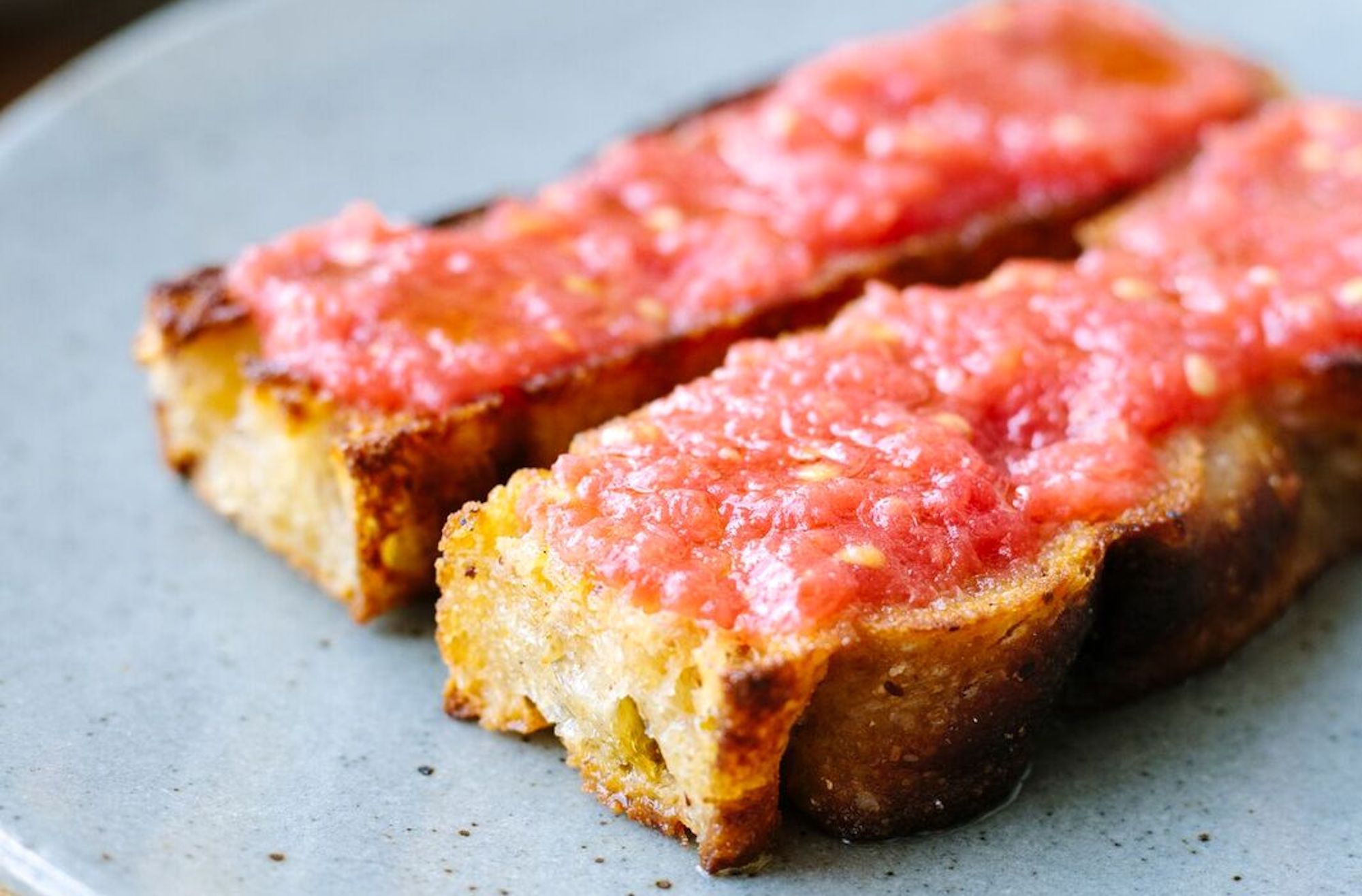
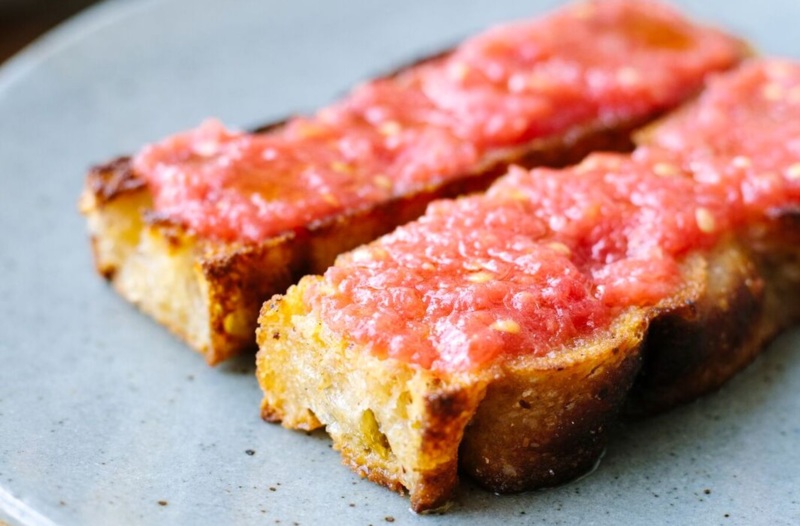
2. Pan Con Tomate
“I think one of our outstanding dishes, and one thing that I eat every single day when I’m in Spain, is pan con tomate. Ours is kind of an ode to all of the ingredients. It’s not traditional. We put a thicker layer of tomato and use a focaccia bread. In Spain, sometimes you have this generic white French bread kind of thing, and it doesn’t really add to the dish. It’s just a vehicle to wipe things up.
The bread, I think, is so important. I love good bread. We use Bub & Grandma’s focaccia. Earlier in the pandemic, we were making our own focaccia because we could handle the volume. I love making bread. I love the whole process. But now we use Bub & Grandma’s because the flavor is so delicious and very consistent. And they’re Eastside, and I like supporting small businesses on the Eastside.
We put the focaccia on the plancha with a bunch of olive oil and get that super-crispy on both sides. That crispiness really supports the tomato. We cut a tomato in half and grate it with a cheese grater. So you’re not getting a purée; you’re not getting a sauce. It’s just a grated tomato. It keeps its juiciness but doesn’t run through the bread. Then we microplane a bunch of garlic into that and add some good olive oil and salt, and that goes on top of the bread. Then we finish with a little more olive oil and Maldon salt. I think it’s the perfect dish.
It’s got enough depth and richness because it’s all about balancing the acid with salt and with garlic. And then texturally, there’s crispy bread, the chunky tomato, and crispy salt on top. I think it’s achieved everything that I want a pan con tomate to be. Put a few slices of jamón Ibérico on it, and it’s pretty excellent.
It’s rare that a table doesn’t get pan con tomate. Some people get several orders. Some people get it at the beginning of their meal, and some people get it at the end because they just love it. When I explain it to guests, the simplicity of it, they’re like, ‘Wow, what’s in it? This is crazy.’ And I’m like, ‘It’s just balancing salt and acid.’”
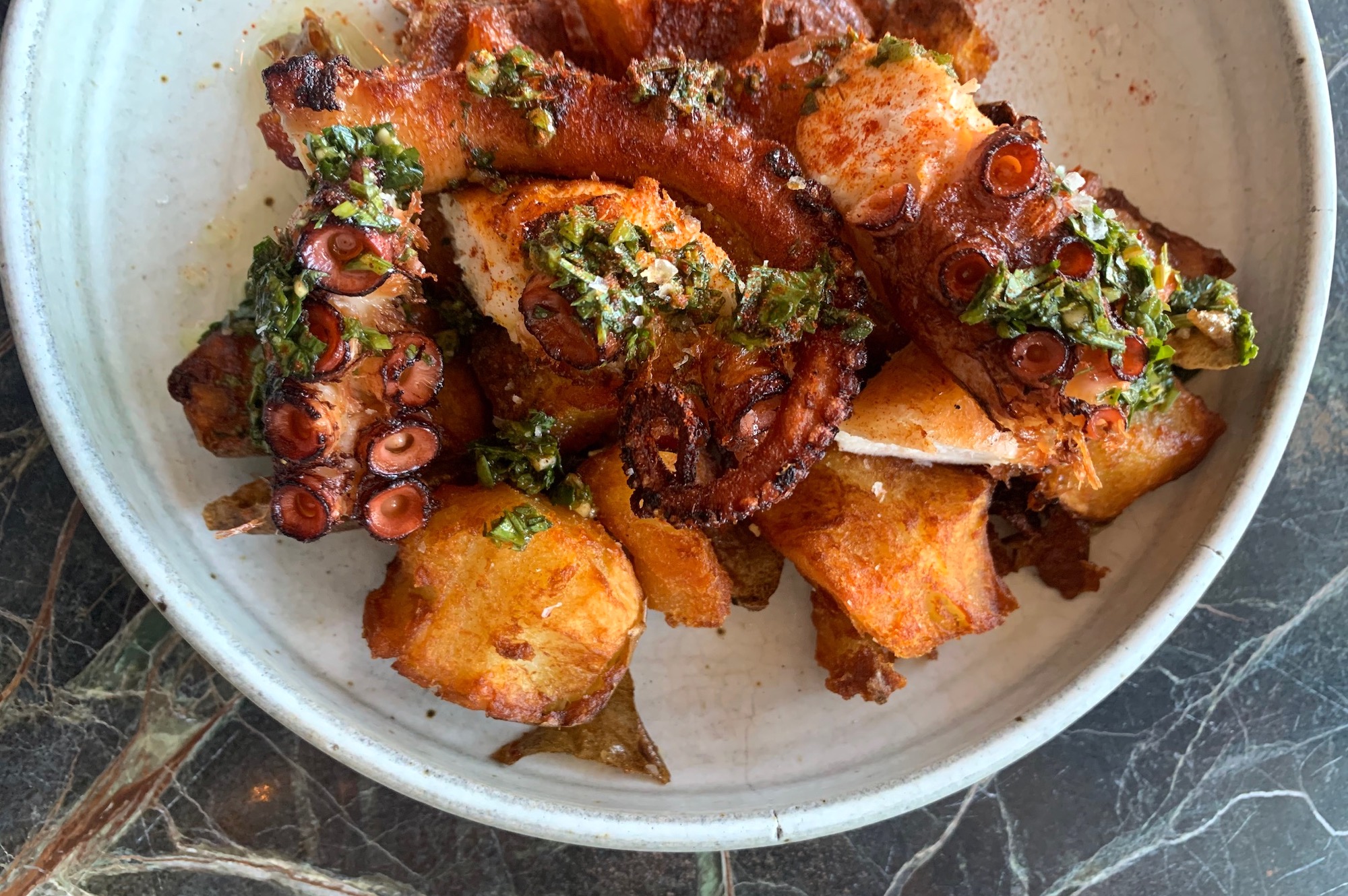
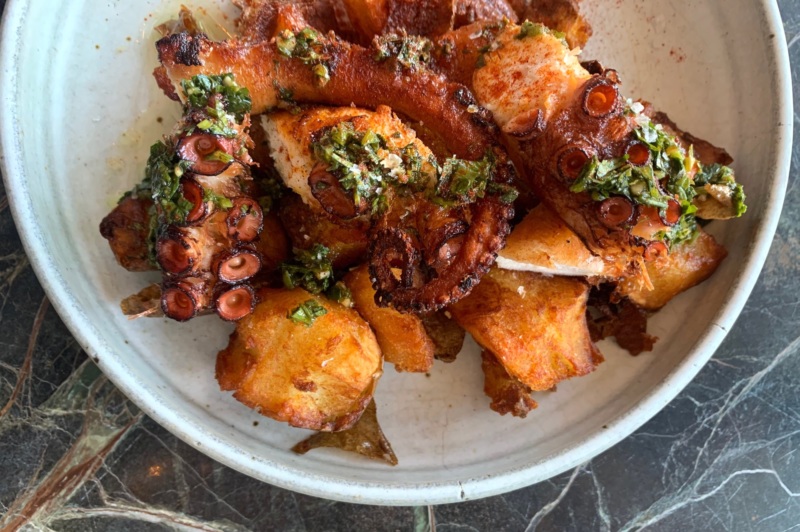
3. Pulpo a la Brasa
“I’ve cooked octopus different ways, but my favorite is just completely submerging it and braising it in beer. Ours is braised in Estrella beer, which is our forever beer on tap, a lager from Barcelona. And it just gives it this meaty flavor. But it also seems to break it down. So it’s just Estrella beer, bay leaf, onion, garlic. We let that go for about three hours. It’s not overcooked. It still has some bounce to it.
Then we break it down, sear it on the plancha with some olive oil, and get the skin crispy. It’s very simple. But it just comes down to, how are we going to treat this thing that you couldn’t bite into raw? How do we tenderize it? We achieve the tenderness by braising it. This is, again, about starting with great product. We use octopus from Galicia. And then it’s just consistency and simplicity.
One thing that’s important is we put the octopus back in the liquid after we braise it. We chill the liquid down, we break down the octopus, and then it stays in the liquid until it’s cooked on the plancha. So it’s not drying out at all. It’s staying juicy.
We make some potatoes. We use fingerling potatoes and cook those in dashi to give them a little more richness. And then we dry them out, crush them, and fry them. They’re crispy and have some umami. And then there’s a bright sherry vinegar-based chimichurri with mint, garlic, parsley, oregano, and shallots.”
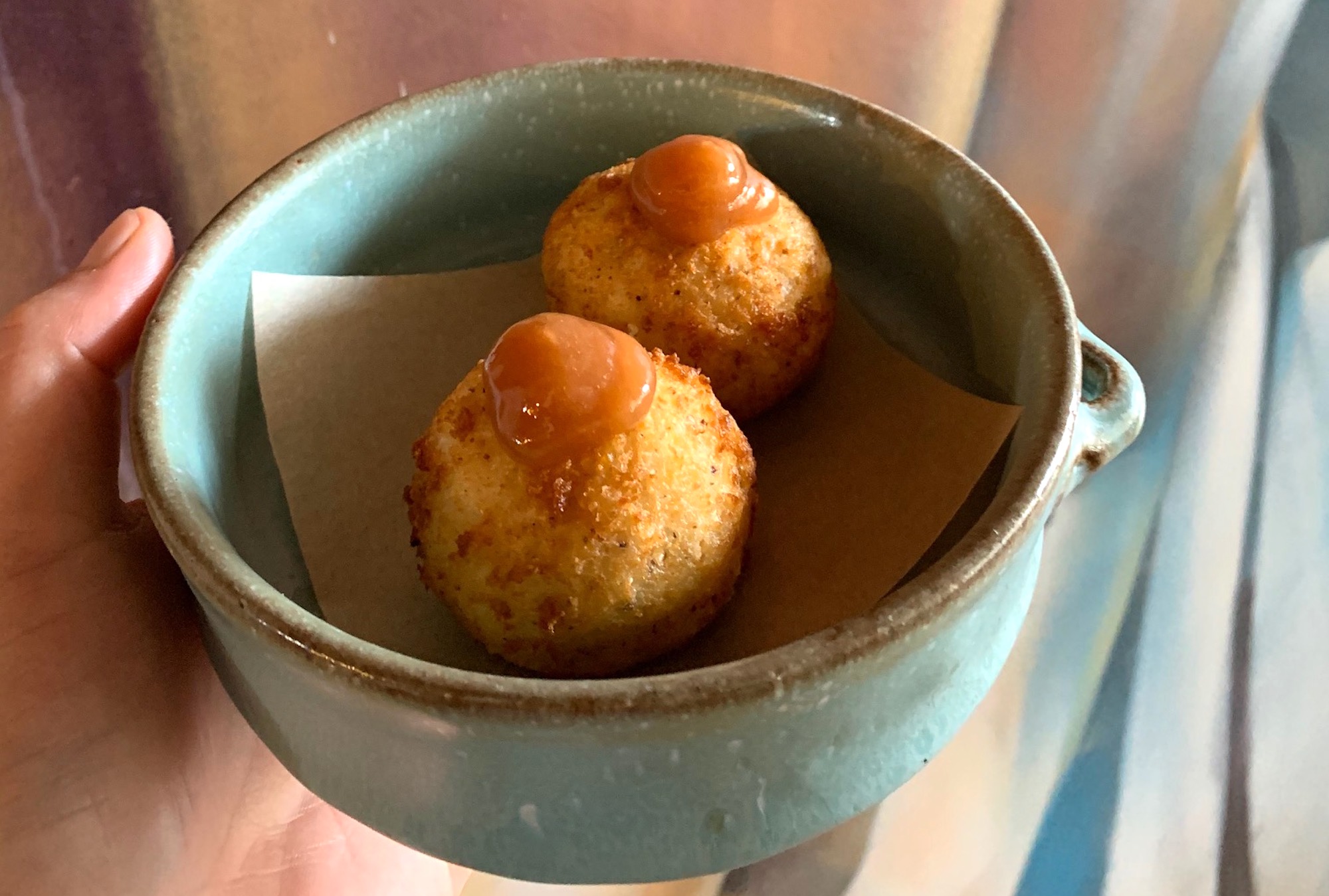
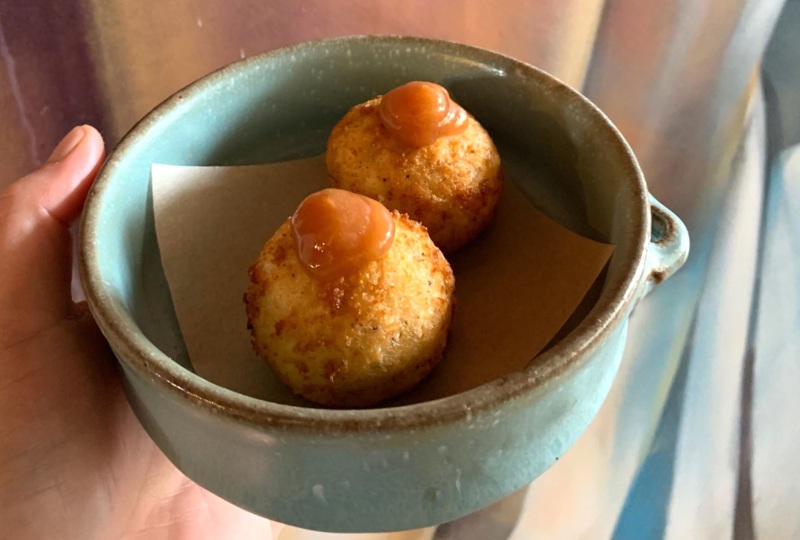
4. Croqueta de Pollo
“There are more Spanish restaurants popping up in Los Angeles, and I’m excited about that. I had croquetas at a new restaurant recently, and it made me think more about croquetas because that’s a whole world, right?
A bechamel can be made with any kind of cream, any kind of protein. One of the cool ones we do is one I did at Ración, and it integrates some Japanese ingredients. We braise chicken in goat’s milk, and we use the braising liquid to make a bechamel. Then we pick the chicken, put that chicken back in, and that’s the base of the croquetas.
For all of our croquetas, the breading is a combination of house breadcrumbs that are made with garlic, olive oil, bread scraps, and panko. I want a lot of crisp, so I add the panko.
The chicken has a sauce that’s membrillo, the quince paste that’s traditionally served with cheese in Spain, and umeboshi. We just blend the two together. And the umeboshi and membrillo, they’re like best friends. They work so well together. There’s a little bit of saltiness and the rich umami, but there’s still nice fruitiness. It’s so delicious.
I think the chicken croqueta is surprising because it’s kind of a play on a cheese plate. You think you’re having goat cheese in the croqueta. But it’s goat milk and then the membrillo. It’s just that tanginess of the goat milk, but then you get that chicken richness and creaminess. And the contrast of flavors between the sauce and the croqueta is really lovely.
So that’s one of our signatures where we’re pulling from other cuisines and really making something I think is truly Spanish. It’s built with all of the parts that are important to a croqueta. It’s the creaminess, the crispiness on the outside, and giving reverence to the Spanish ingredients. I also really got into Spanish food because of the rise of El Bulli when I was coming up as a cook. I love the innovation and thinking outside the box and the freaking let’s turn this on its head approach. The avant-garde is fascinating. That’s where I’ve always taken my cues as a chef. I could do a classic croqueta, but how do we turn this on its head? That’s always how my brain works.”
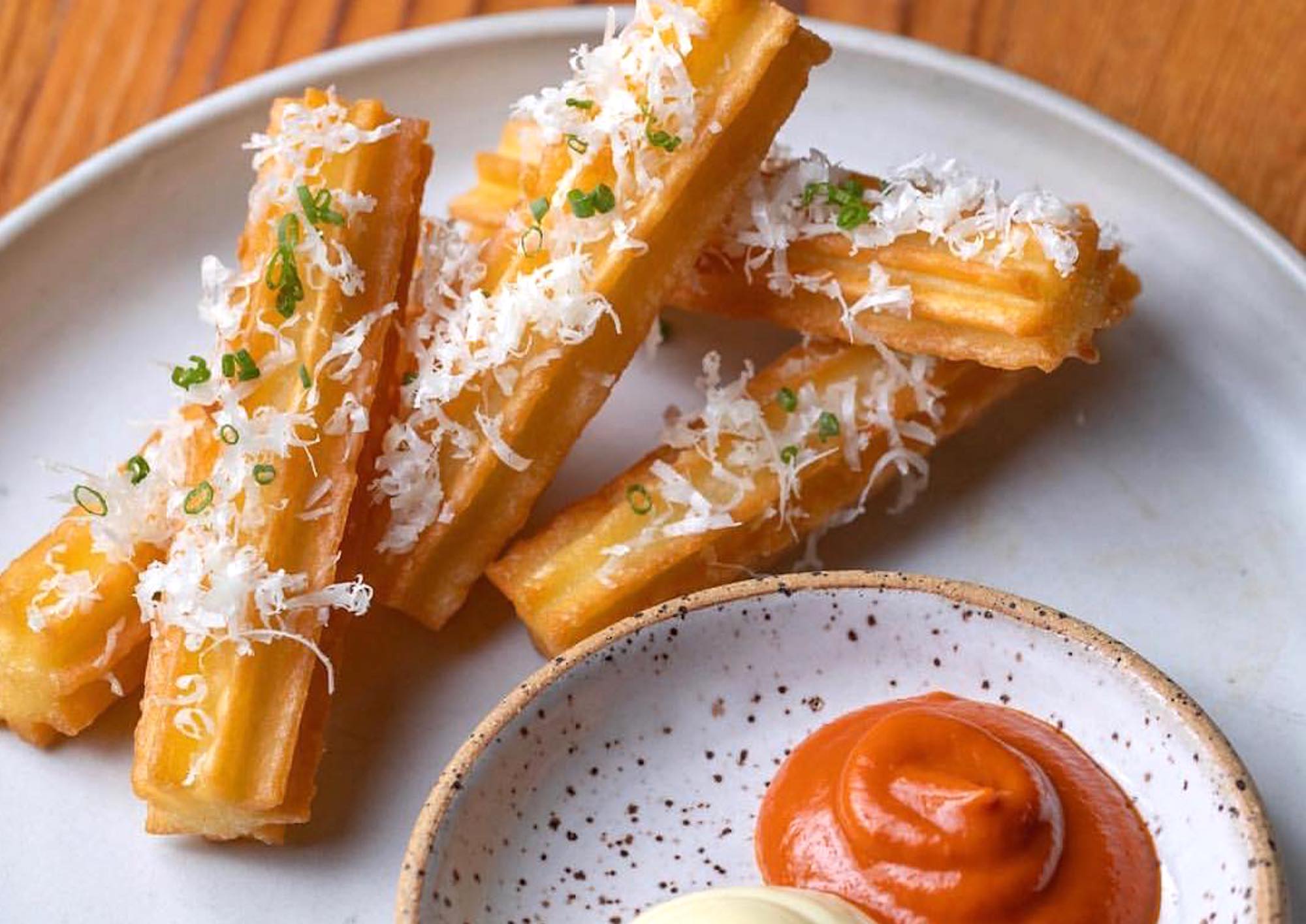
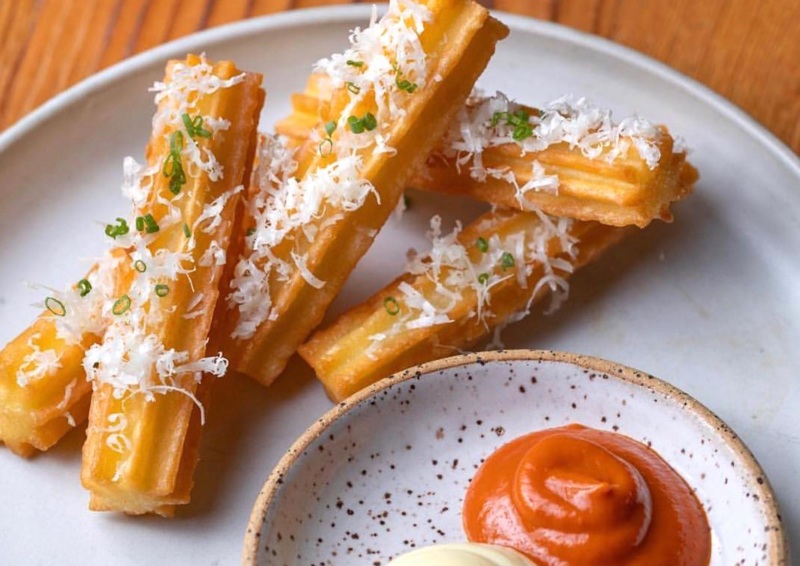
5. Patatas Bravas
“I have to stay interested in my food. I have to keep it fun for me and for the guests, too. That’s why we do patatas bravas the way we do. I can’t just chop up potatoes, throw them in the fryer, and squeeze a bunch of aioli on them.
We make a potato churro. If guests have had patatas bravas before, they know ours is playful. And it’s that playfulness that I think the Spanish have embraced so much. I think my food gives reverence to what Spanish food is, from the traditional tapas to the modernist approach.
I tested the savory churro in all kinds of different ways. And then I was like, let’s do a pâte à choux and fold in a really nice potato purée. That ended up being potatoey enough, and it keeps a shape, and it almost tastes like a big rich French fry because it’s gooey in the middle. It isn’t fully crisp all the way through.
When I describe it to somebody, I say, ‘Well, it’s like this Spanish French fry.’ But I kept the sauces really classic: garlic aioli and salsa brava, which is just a spicy tomato sauce. And that way, people can just travel through those flavors and get to the same place as I’m going. They want patatas bravas, I’m going to give them patatas bravas, but we’re taking different routes to get there.”
Andy Wang has written regularly about restaurants for publications including Food & Wine, Los Angeles magazine, and Robb Report. He was previously the real estate and travel editor at the New York Post. Follow him on Twitter and Instagram. Follow Resy, too.















